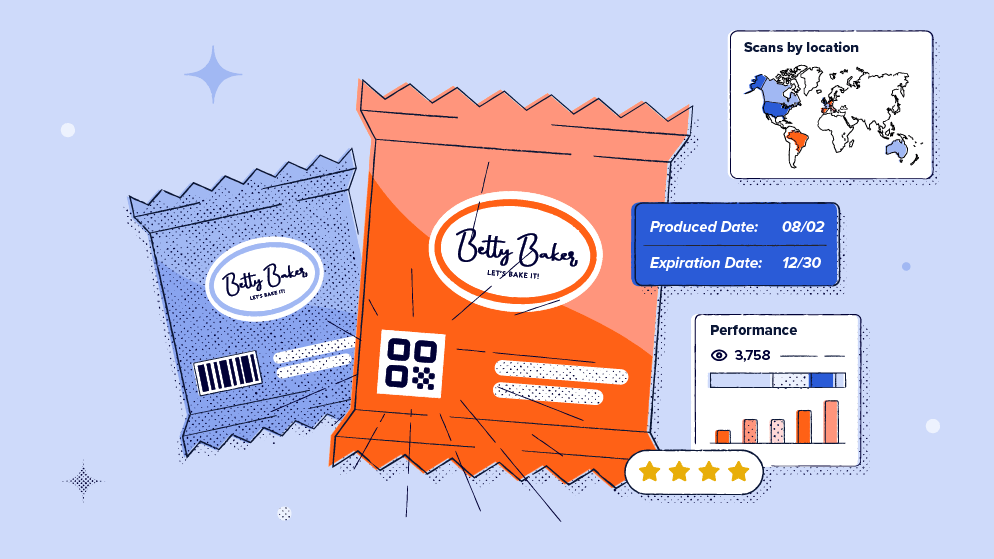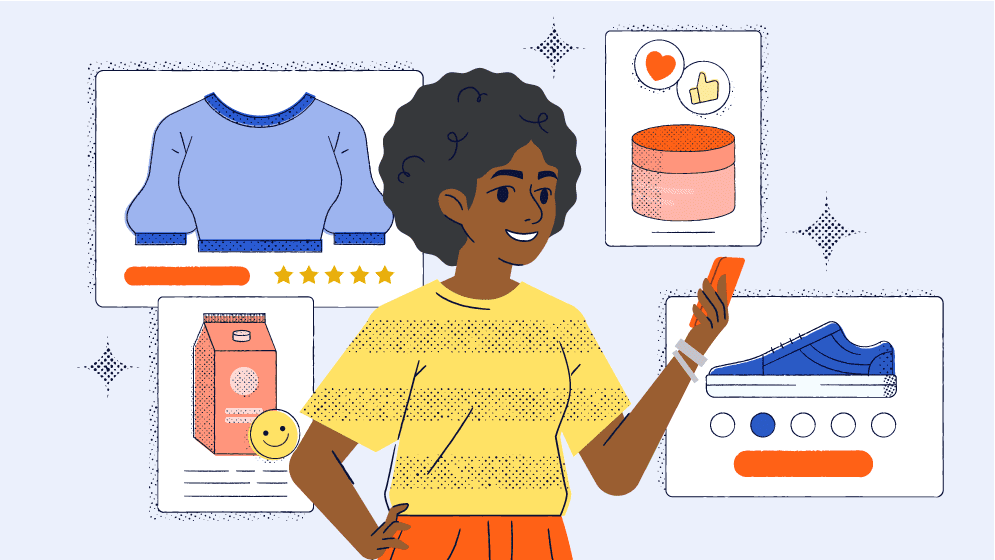The Consumer Packaged Goods (CPG) sector is a bustling arena of competition where industry giants wrestle for shelf dominance alongside emerging brands. Toss in the dynamic wave of e-commerce and the challenges brought on by global inflation, and you’ve got a recipe for the ever-shifting landscape of CPG.
In this article, we’re delving deep into the heart of the industry, unraveling ongoing CPG trends, and more.
What is CPG (consumer packaged goods)?
CPG refers to items that consumers use daily, and therefore replace regularly. CPG products typically have a limited lifespan. Examples include food, beverages, cosmetics, medication, clothes, cleaning items, and personal care products. These items are typically sold in brick-and-mortar stores and online retail stores, but also on social media.
What is the Consumer Packaged Goods industry?
The Consumer Packaged Goods (CPG) industry is a major powerhouse in the US economy, making a significant impact on both employment and economic growth. To put it into perspective, the sector provides a staggering 20.4 million jobs.
But that’s not all: the CPG industry also adds a whopping $2 trillion to the Gross Domestic Product (GDP). It’s not just about the products you see on the shelves; the CPG industry plays a crucial role in shaping job markets and influencing the overall economic landscape in the US.
In the competitive market of CPG, the numbers speak volumes. Back in 2022, the industry was already making waves with a market size that exceeded 160.75 billion USD. Fast forward to the future, and we’re looking at a forecasted surge to an impressive 244.92 billion USD by 2030.
Bonus: Learn how QR Codes can help boost sales in the growing CPG market!
4 types of consumer goods
Let’s explore the intricacies of the four consumer goods groups: convenience goods, shopping goods, specialty goods, and unsought goods, delving into each type for a more comprehensive understanding.
Convenience
Convenient items are those essential purchases that consumers routinely buy without much deliberation. Think of everyday products like laundry detergent, bread, toilet paper, over-the-counter (OTC) medicines, and more.
Shopping
Shopping goods demand more time for decision-making, are bought less frequently, and typically come with a higher price tag. This category includes items such as clothing, electronics, appliances, and furniture.
Specialty
These are products exclusive groups of customers will buy, driven by unique features and strong brand associations. Think Rolex watches and Gucci bags. Consumers exhibit fierce brand loyalty, often hesitating to accept substitutes.
Common examples of these items are designer clothing, luxury cars, famous artwork, high-end jewelry, professional camera equipment, and more.
Unsought
Unsought goods, in contrast to convenience items, are essential but typically unpleasant purchases that consumers don’t actively think about. Examples include fire extinguishers, smoke detectors, cemetery plots, and similar necessities
Characteristics of CPG
Consumer packaged goods often fit into the convenience goods category, primarily because of their widespread availability, which aims to simplify consumers’ lives.
Requiring minimal consideration in the purchasing process, retailers ensure an ample supply on their shelves. This abundance allows consumers to easily access and repurchase these products shortly after replenishment.
On a macro level, we can also analyze CPG characteristics through this lens:
- Bought regularly: Customers make daily purchases of products such as toothpaste, toilet paper, fruit and vegetables, dairy products, meat, and more.
- Rapid consumption: These items are consumed frequently, leading to regular restocking.
- Low cost: Everyday items like these are relatively affordable for most consumers.
- High volumes: These products are produced and sold in bulk.
- Large-scale distribution: CPG items are widely available as most, if not all, consumers depend on these products.
- Low consumer engagement: Due to the frequent nature of these purchases, consumers spend less time deciding on CPG items.
Consumer Packaged Goods examples
Now we’ll take a closer look at specific sub-industries within CPG. This includes segments like food and beverages, beauty and personal care, wellness and health, apparel and footwear, and household products.
Food and beverages
The food and beverage industry has experienced significant change in recent years, driven by the COVID-19 pandemic, resulting in monumental consumer preferences and behavior shifts. Notably, there has been a growing interest in healthier eating habits, leading to discernible changes in consumer needs.
These changes manifest in various ways, including a rising demand for plant-based products and immunity-enhancing products, a preference for food and beverages with reduced sugar content, and an overall inclination toward healthier choices.
Products falling under this category span a wide range, encompassing fruit and vegetables, both meat and plant-based alternatives, chocolate, frozen foods, dairy products, cereals, soft drinks, water, juice, alcoholic beverages, and more.
Key players in the food and beverage industry under the CPG sector include renowned companies such as Unilever, Kellogg Company, McCain, Tyson Foods, Nestlé, Coca-Cola Company, and Pepsi.
Beauty and personal care
The beauty and personal care industry has been undergoing fascinating shifts in recent years, showcasing its dynamic nature and growth.
Consumers are leaning toward brands that value transparency, sustainability, and social responsibility. Some trends include a rising interest in personalized beauty products, where customization and clean ingredients take center stage. There’s also a prominent uptick in the popularity of men’s personal care items, reflecting a broader embrace of self-care.
This diverse industry offers a wide array of products, from haircare and skincare to oral hygiene, makeup, and fragrances. Recognizable names like L’Oreal, Estée Lauder, Colgate-Palmolive, Morphe, and Procter & Gamble are key players shaping the landscape of this ever-evolving market.
Wellness and health
As healthcare costs continue to soar, a growing number of customers are turning to pharmacies for OTC medications to address their health concerns.
Several key trends have emerged in the pharmaceutical industry. Consumers increasingly prioritize wellness and prevention, relying on online research and considering doctors only as a last resort.
There’s also a shift towards purchasing products based on their ingredients rather than brand names and a growing demand for drug transparency and natural ingredients free from GMOs.
Product examples in this industry include vitamins, supplements, and OTC medications. Notable brands in this space are Johnson & Johnson, Your Super, GSK, Novartis, Bayer AG, and Sanofi.
Apparel and footwear
The apparel and footwear sector within the CPG industry is thriving, showing no signs of slowing down. Key trend themes in this industry reveal a changing landscape where consumers progressively hold brands accountable for catering to a more diverse range of body types, skin tones, and sizes.
A significant shift is the growing impact of social media, particularly the boom in influencer marketing and social selling, playing a major role in shaping consumers’ purchasing decisions. This reflects a broader trend of consumers seeking authenticity and relatability in the brands they choose.
Another noteworthy development is the movement away from fast fashion brands, with consumers gravitating towards slow fashion alternatives that prioritize quality, durability, and timeless style. This signals a conscious effort by consumers to make more sustainable and thoughtful fashion choices.
CPG brands operating in the clothing and footwear space include a variety of players, such as Nike, Adidas, Uniqlo, H&M, Burberry, and Allbirds.
Household products
Emerging consumer preferences in the household cleaning industry reveal a growing inclination toward store-bought and generic products over branded alternatives. There’s a noticeable surge in the popularity of plant-based and natural ingredient products, with consumers favoring them over their chemical counterparts.
Brands aligning with sustainability initiatives are experiencing increased traction, and there’s a notable uptick in the adoption of smart home cleaning technology.
These shifts encompass various products, including cleaning supplies, laundry products, paint, pesticides, and more. Leading the way in the industry for household products are brands such as Henkel, Bath & Body Works, Blueland, Etee, Tru Earth, Lively, Tide, and many others.
Six changes within the CPG industry
The waves of change within CPG are neverending. Let’s look at six key changes on the horizon.
1. An uptick in online media is influencing consumers’ buying decisions
Consumers are relying on social media sites, influencers, apps, and online stores to both research and purchase products.

2. Continual increase in online shopping because of convenience
Consumers are prioritizing frictionless shopping experiences because of the freedom to make quick purchases and have products delivered directly to their doorstep. This convenience makes online shopping an attractive alternative.
3. Greater interest in health-related products and brands that promote sustainability
Even as the impact of the COVID-19 pandemic wanes, consumers continue to prioritize health-conscious choices. Simultaneously, there has been an increase in sales for brands actively championing sustainability.

Hot tip: Discover how QR Codes can help brands with their sustainability initiatives on our blog.
4. A shift towards private labels over popular brands
More and more consumers are recognizing the value of choosing store-branded products, contributing to a sustained increase in sales.
5. Direct-to-consumer (DTC) brands have gone vogue
DTC brands have become more popular among tech-savvy generations like Gen Z and millennials. What makes them particularly appealing is that consumers enjoy a more personalized experience, tailored to their specific needs and preferences.
6. QR Code growth
QR Codes are on the rise in the CPG industry, gaining momentum year after year. This trend creates a valuable opportunity for CPG brands to leverage QR Codes, offering innovative experiences to engage with their customers.
Did you know? Bitly’s GS1-compliant 2D Barcode is the perfect solution for CPG businesses. GS1, the not-for-profit organization that establishes and manages universal barcode standards, is gearing up to transition from the traditional 1D barcode to the more advanced 2D barcode worldwide. Learn more about Bitly’s 2D Barcode.

CPG FAQs
Do you still have uncertainties about what CPG is all about? Then this section is just for you!
What are examples of consumer packaged goods companies?
Examples of CPG companies include Unilever, Uniqlo, Bayer AG, Nestlé, H&M, Johnson & Johnson, Colgate-Palmolive, Adidas, Coca-Cola, Nike, and L’Oreal.
What is the difference between FMCG and CPG?
FMCG, or fast-moving consumer goods, is often used interchangeably with CPG. The overlap between CPG and FMCG occurs because CPG encompasses a broader range of products, including fast-moving consumer goods. The key distinction lies in the emphasis on the ‘fast-moving’ aspect of FMCG.
CPG includes a diverse array of products, ranging from quickly consumed items to slower-moving products like perfumes, clothing, and electronics that aren’t replenished as frequently.
In contrast, FMCG specifically refers to everyday essentials like bread, milk, beverages, laundry detergent, and personal care products, which are consumed daily or weekly, and typically have a shorter shelf life than some items in the broader CPG industry.
What are the four types of consumer goods?
- Convenience goods: Everyday items that require minimal effort in the purchasing process.
- Shopping goods: Items bought less regularly that require more time investment in decision making like furniture or electronics.
- Specialty goods: One-of-a-kind, high-quality items like luxury cars and designer bags.
- Unsought goods: Infrequently bought items considered necessary but undesirable, such as life insurance.
Elevate your CPG brand with Bitly QR Codes
The CPG industry is a vast landscape. In this dynamic environment, adaptation is key to staying relevant. As the industry transforms, CPG businesses must pivot and meet customers where they are.
Enter Bitly QR Codes and 2D Barcodes—our powerful tools to establish direct connections with your audience. On the Bitly Connections Platform, you can get a bird’s-eye view of how your customers engage with your products!
Sign up for a free account and unlock the potential to create lasting connections that resonate with your customers.




